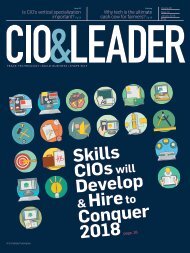C&L October 2017_LR (5)
You also want an ePaper? Increase the reach of your titles
YUMPU automatically turns print PDFs into web optimized ePapers that Google loves.
Book Review<br />
I<br />
t is ironic that in a culture where sacred texts start<br />
with teaching the importance and characteristics of<br />
the divine ‘wholeness’ (the invocation of Isa Upanishad),<br />
thinking in whole or ‘system thinking’ is so<br />
conspicuous by its absence.<br />
Never has the importance of ‘system thinking’<br />
been as evident as it is now, as the world becomes<br />
increasingly interconnected; and solving problems<br />
in isolation can no longer said to be a valid, let<br />
alone sound, method.<br />
What is more, with technology making things<br />
more and more open and interconnected, people are<br />
increasingly realizing the value of the ‘whole’—that<br />
is not segregated into small parts, thus breaking<br />
a hundreds-of-years old legacy of reductionist<br />
approach. Whether it is the Internet itself or the<br />
ctyptocurrencies and blockchain, they proclaim the<br />
superiority of this systems approach, where complex<br />
systems with no one centrally controlling it<br />
have provided immense value and benefit to a world<br />
which still sees thing, by and large, in parts.<br />
‘System thinking’ is becoming essential for businesses<br />
to succeed. A book for practicing managers<br />
on the subject, like Systems thinking for Effective<br />
Managers: The Road Less Traveled by Prashun<br />
Dutta and published by Sage, hence, is an extremely<br />
relevant and timely effort.<br />
Dutta, who has served both as a management<br />
consultant and a CIO (Tata Power and Reliance<br />
Infrastructure), is no stranger to the real life situations<br />
and expectedly the book is replete with typical<br />
situations that managers can relate to.<br />
“Attempts at isolating problem situations and then<br />
developing solutions for the same without considering<br />
the whole context are most likely to fail. In this<br />
regard, one has observed the practice of trying to<br />
import a solution that may have worked elsewhere.<br />
While one may adopt the thinking behind a solution<br />
implemented elsewhere, it will necessarily have to<br />
be adapted to the context at hand,” writes Dutta.<br />
How familiar it sounds! Few practicing managers<br />
would fail to identify with such situations.<br />
There are many ex<strong>amp</strong>les from real corporate<br />
world—from manufacturing companies to IT companies;<br />
from business issues to IT project management.<br />
Once you go through them, you will surely<br />
relate to them.<br />
The challenge, however, is to find them as they<br />
seem almost hidden inside the descriptive text. That<br />
is the essential issue with the book. It is neither a<br />
‘chicken soup’ for the managers, written in heady<br />
easy-to-refer format nor is it a systematic primer to<br />
‘system’ thinking. Nor for that matter, and out-andout<br />
academic book, though Dutta’s work does exude<br />
significant academic indulgence.<br />
The book is essentially presented as a journal<br />
of the author’s learning journey, though loosely<br />
categorized into various aspects of ‘systems’ thinking—right<br />
from basic definitions to areas such as<br />
complexity management, management styles and<br />
leadership. The author tries to show the utility of<br />
systems thinking or looking for the big picture,<br />
which he confesses to have discovered as being<br />
synonymous with wholeness or completeness of the<br />
picture and not really their ‘bigness’.<br />
Essentially it is a reader’s book; not a referrer’s<br />
book. You have to invest time to read it sequentially<br />
and absorb. The original analysis and presentation<br />
style of the author is sometimes very enlightening<br />
and engaging. But you must fully commit<br />
to it. It is not a book that you can flip through. So,<br />
for those going through a training program or<br />
academic program, it is a welcome addition to systems<br />
approach literature—a book with so much of<br />
practical insight. But it is not a book that will help<br />
you on the go. To that extent, the name may be a<br />
bit misleading.<br />
In essence, it is a very good book on systems thinking<br />
for those who are willing to invest on learning;<br />
not a guide book that can be referred at will.<br />
<strong>October</strong> <strong>2017</strong> | CIO&LEADER<br />
25














